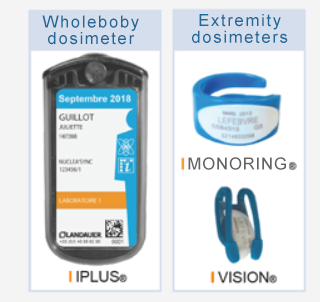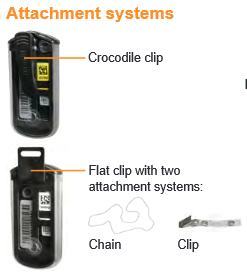
According to most national regulations, workers exposed to ionizing radiation must have an individual dosimetry monitoring with a passive dosimeter at least.
To ensure optimal monitoring, their wearing must respect several conditions. If necessary, contact your Radiation Protection Adviser (RPA) or your Radiation Safety Officer (RSO).
 Mandatory
Mandatory How to use an area dosimeter?
How to use an area dosimeter?It monitors either the controlled areas or the adjacent unclassified rooms to confirm the doses remain within the dose limits stated in the regulation. They are also performed outdoor especially for perimeter monitoring of Nuclear facilities.
It is ideally fixed at chest height in the room to be controlled.
Learn more about area dosimeter
 How to use a control dosimeter?
How to use a control dosimeter?It is used to estimate the background radiation and accidental irradiation for example during the transport. The worker dosimeter doses are subtracted to the control dosimeter in order to obtain a dose measurement only linked to professional activity.
It is essential that the control dosimeter is neither worn nor used to measure the ambient dose.
It remains on the badge board during the entire period of dosimeter use (indicated on the label).
Learn more about control dosimeter
 How to use a visitor or a “non-nominative” dosimeter?
How to use a visitor or a “non-nominative” dosimeter?LANDAUER® provides visitor badges that can be assigned to visitors and/or new employees.
The dosimeter can be assigned to a worker using the “Assign a dosimeter’ menu on LANDAUER Direct.
Wear period
The wearing period is easily identified by an identical color for all types of dosimeter. This allow to identify easily the dosimeters that should not be worn and ease the logistics during two wear periods.
Identification of the wearer
The name is written in full on all LANDAUER dosimeters: IPLUS, MONORING and VISION.
 IPLUS, whole body dosimeter
IPLUS, whole body dosimeterIt is worn at chest level.
You can fix it:
The dosimeter’s label must face the radiation source. With the isotropy of the dosimeter, the reverse wearing is possible if there is no source which emitted beta or neutron.
If wearing Personal Protective Equipment (PPE), such as lead apron, you must put the dosimeter under it. Some country regulations impose also to wear a second dosimeter above the lead dosimeter.
Wear your ring on the finger designated by your RSO / RSA.
Two possible carrying areas: right or left hand.
The cap should be oriented to face the radiation source.
For more comfort, the MONORING is available in two sizes M or L.
Three possible wearing zones: right, center or left.
Wear VISION in the location designated by your RSO / RSA corresponding to the maximum dose measured during the workstation studies. The dosimeter must be placed as close as possible to the lens without obstructing the view.
Outside the workstation study, VISION is worn with the cap behind the leaded protection of your glasses.
The hook should not be removed from the detector.
For better adaptation to the thickness of the mount, VISION is available in two sizes.